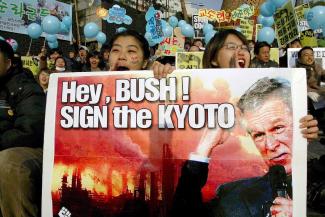Climate finance
Climate-finance commitments are not being met
 picture-alliance/dpa/dpaweb/Jeon_Heon-Kyun
The USA has a long history of slowing down climate action: protesters in Seoul in 2005.
picture-alliance/dpa/dpaweb/Jeon_Heon-Kyun
The USA has a long history of slowing down climate action: protesters in Seoul in 2005.
Climate-related finance is a broad term. Generally speaking, it means funding (either public or private) for reducing greenhouse-gas (GHG) emissions or adapting to the impacts of climate change.
Given that governments only have indirect discretion over private finance flows, we will focus on public finance in this essay. Public climate finance follows different avenues:
- It can be delivered through mechanisms established alongside the climate regime, such as the Global Environmental Facility (GEF), which then allocate funding to climate-related activities.
- Money can also be allocated via other multilateral institutions, especially multilateral development banks, which then fund efforts in developing countries.
- Finally, it can be delivered bilaterally, according to agreements between high-income and developing countries.
Tackling global environmental challenges
Climate finance is thus directly related to climate-change mitigation, climate adaptation or both. However, it may also target broader objectives, for example, nature-based solutions for infrastructure purposes in line with the objectives of the three so-called Rio conventions. Apart from the UNFCCC, the UN Convention on Biodiversity and the UN Convention to Combat Desertification were on the agenda of the Earth Summit in Rio de Janeiro in 1992. Global environmental objectives include:
- limiting global warming to less than 2° C compared to pre-industrial levels,
- halting further loss of biodiversity,
- protecting land and marine ecosystems and
- stopping land degradation.
Biodiversity finance aims specifically to stop or reverse nature loss in order to protect human health and prosperity. Progress on this front was recently made at the 2022 UN Biodiversity Conference in Kunming-Montréal. For example, the summit foresaw an annual $ 20 billion of biodiversity funding from 2025, rising to $ 30 billion from 2030.
The climate summit in Sharm el Sheikh in 2022, moreover, decided to establish another form of climate finance. Loss and damage funding is supposed to compensate vulnerable countries for harm already caused by climate change. However, UNFCCC members did not reach an agreement on how loss and damages will work in practice, so progress cannot be evaluated yet.
Three caveats should be made before looking at the progress high-income countries have made in providing public finance:
- A political commitment is different from a legally binding goal.
- Committed and disbursed funding are not synonyms.
- Actual results depend on disbursed money being used for tangible purposes. Assessing whether that is the case is extremely important, but beyond the scope of this article.
$ 100 billion a year
At the Copenhagen climate summit in 2009, developed countries pledged to jointly mobilise $ 100 billion per year by 2020 to address climate change in developing countries. The decision was a rare example of a quantified climate-related finance target. The pledge was formalised one year later. The Paris climate summit decided that $ 100 billion per year should be seen as a minimum, not a goal. The pledge included public, private, bilateral, multilateral and alternative funding.
So far, the pledge remains unfulfilled. Its reiteration along with the promise to live up to it soon have become an awkward ritual of the UN’s annual climate summits. The gap seems to be closing, but progress has been painfully slow.
In 2022, the OECD published data on climate finance for the years 2013 to 2020. In that time span, disbursements increased by almost 60 %, from $ 52 billion in 2013 to $ 83 billion in 2020. Public finance (both bilateral and multilateral) played the largest role. Its share in total increased, from 73 % ($ 38 billion) in 2013 to 82 % ($ 68 billion) in 2020.
Assessments from WRI and ODI
The World Resources Institute (WRI), an independent think tank based in Washington D.C., also analysed finance for the period from 2013 to 2018. Adjusting data to eliminate double counting, it presented smaller numbers than the OECD. According to the WRI, bilateral and multilateral climate finance from high-income to developing countries amounted to only $ 22 billion in 2013 and $ 33 billion in 2018. Including outflows from multilateral development banks, the figures rose to $ 34 billion in 2013 and $ 55 billion in 2018.
According to either data set, high-income countries did not collectively meet their pledges. Attempts to break down responsibility country by country show that very few are contributing enough. The failure fits a pattern. In 1970, high-income countries pledged to spend an annual 0.7 % of their gross national income (GNI) on official development assistance (ODA). Collectively, they only disburse about 0.33 % of their joint GNI.
The WRI’s analysis assessed how much each developed country should contribute towards the $ 100 billion/year goal considering their GNI and population, which are proxies for responsibility and capacity for climate action. The authors calculated countries’ fair share based on two different scenarios. The first was that at least $ 70 billion of the total should be public finance. The second was that public finance would cover $ 100 billion, given that this amount is a floor, not a target. The WRI concluded that, in 2018, only Austria, Denmark, France, Germany, Japan, Norway and Sweden paid their fair share under the first scenario, and only France, Germany, Japan, Norway and Sweden did so under the second.
Britain’s Overseas Development Institute (ODI) similarly concluded that in 2017/2018, only Norway, Sweden and Germany provided their fair share, with France and Japan coming close. The USA was at the bottom, providing a mere four percent of its fair share.
Why countries fail to comply
There are several reasons why developed countries fail to fulfil their pledges. First of all, there is no sanction for non-compliance. Most climate commitments are toothless, even if they are considered legally binding. Removing the threat of sanctions makes negotiations easier, but the price is a lack of incentives for countries to comply.
The collective nature of the pledge is another factor. At first glance, a collective pledge is easier to make since individual partners do not commit to a specific sum. In the longer run, of course, it is difficult to hold individual countries accountable for collective failure if there never was a clear agreement on burden sharing.
In addition, there is still a lot of debate about how to implement the principle of Common But Differentiated Responsibility and Respective Capabilities (CBDR) within the UNFCCC. According to this principle, high-income countries should provide climate-related finance to developing countries. Yet countries disagree about how they should be held accountable for past emissions, and how current emissions should be addressed. These arguments generate more heat than light. As a matter of fact, no country is a monolithic entity, so governments pay attention to a variety of interests. Moreover, country groups are very heterogeneous too.
Growing polarisation
Finally, the international system is changing, and those changes have impacts on climate negotiations. Strategic competition of the USA and China is increasingly polarising the multilateral scenario, with countries taking sides on political, economic and technological issues. The Covid-19 pandemic and the war in Ukraine have further deepened the divide.
It also matters that the US has a long history of slowing down climate action. In 2001, President George Bush Jr. withdrew from the Kyoto Protocol, arguing that it created an unfair trade advantage for China. In 2017, President Donald Trump withdrew from the Paris Agreement. Although President Joe Biden has reinstated climate change as a key issue, the current fragmentation in American politics makes it less likely that the US will assume its fair share of responsibility. Tensions between the two countries affect prospects for international cooperation in general. Like the rest of the world, both the USA and China have a rational interest in tackling climate change. Yet it remains to be seen if they will be able to collaborate in this area as competition on other issues increases.
References
OECD, 2022: Aggregate trends of climate finance provided and mobilised by developed countries in 2013–2020.
https://www.oecd-ilibrary.org/sites/d28f963c-en/index.html?itemId=/content/publication/d28f963c-en
ODI, 2021: A fair share of climate finance? Apportioning responsibility for the $100 billion climate finance goal.
https://odi.org/en/publications/a-fair-share-of-climate-finance-apportioning-responsibility-for-the-100-billion-climate-finance-goal/
WRI, 2021: A breakdown of developed countries’ climate finance contributions towards the $100 billion goal.
https://doi.org/10.46830/writn.20.00145
Larissa Basso is a researcher in international environmental politics.
larissabasso@gmail.com
Eduardo Viola is a professor of international relations at the University of São Paulo, the University of Brasília and the Getulio Vargas Foundation.
eduardo.viola@fgv.br



